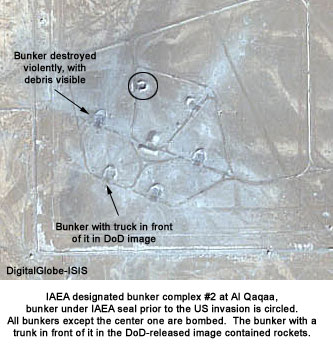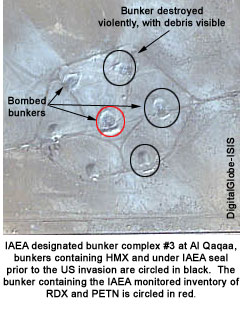Reports
Fate of High Explosives at Al Qaqaa Still Unknown: Increasing Indications That Some Looted: Satellite photos show some bunkers that contained HMX were intact months after the fall of Baghdad
by David Albright and Corey Hinderstein
November 4, 2004
| Satellite images of Al Qaqaa from November 11, 2003 Click thumbnail to open, images will open in a new window | |||
 |  |  |  |
| Al Qaqaa | Bunker complex 2 | Bunker complex 3 | Bunker complex 4 |
Since October 25, 2004, debate has swirled about the fate of extremely powerful high explosives at the Al Qaqaa site in Iraq. The material in question is about 330 tonnes (363 American tons) of RDX, HMX, and PETN. Nine bunkers containing 194.7 tonnes of HMX, the most powerful of the high explosives, were under International Atomic Energy Agency (IAEA) seal according to a January 14, 2001 internal IAEA document recording the details of a monitoring inspection at Al Qaqaa1. The seals, which were attached to the entrances of each bunker, remained intact as of early March 2003 when the IAEA last visited the site.
According to IAEA spokeswoman Melissa Fleming, 5.8 tonnes of PETN and 3 tonnes of RDX were stored at Al Qaqaa and 125 tonnes of RDX were also stored at Muaskar al Mahawil, about 30 miles away under Al Qaqaa administrative control2. The IAEA was monitoring the amounts of RDX and PETN but did not put those bunkers under seal. In total, Al Qaqaa had 203 tonnes of high explosives and Muaskar al Mahawil had 125 tonnes of RDX. The following overhead images show the Al Qaqaa bunker complex on November 11, 2003, and indicate which of the 55 bunkers were under IAEA seal. Eighteen bunkers were bombed or otherwise destroyed at the time of this DigitalGlobe satellite photo. Three bunkers may have sustained damage from internal, or secondary, detonation because the photos show debris around the bunker sites instead of just empty spaces with some remaining walls. Two of these three bunkers were completely structurally destroyed, while the third maintained the shape of the back wall. Secondary explosions may have been caused by detonation of the stored material after an air attack during the war. US troops on the ground could have also destroyed the bunkers in a way that caused a large secondary explosion, but this would have been a risky practice and appears to be at odds with known US efforts to remove ammunition to a central location.
At least four of the nine bunkers that were under IAEA seal were not destroyed, so the fate of the material that was contained therein remains a mystery. Based on information about the IAEA seal numbers contained in an IAEA inspection record, the crew from Minneapolis ABC affiliate KSTP filmed an intact seal on the door of bunker 38, one of the bunkers visible as of November 11, 2003. These pictures show that looting could have occurred after US troops visited the site because bunkers that contained HMX remained intact. If all the bunkers had been destroyed, then it could be reasonably assumed that the US troops systematically destroyed the bunkers not destroyed during the war or destroyed the high explosives on site after the war. The fact that many of the bunkers remained intact, including four that were known to contain HMX, means that high explosives may have remained in the bunkers unsecured and available to looters. A priority remains determining whether the HMX and other high explosives were destroyed by U.S. troops or looted by Iraqis. Similarly, the fate of the RDX at Muaskar al Mahawil should be determined. The Pentagon asserted that the amount of high explosive missing from Al Qaqaa is a small fraction of the nearly 400,000 tons of “ammunition” secured in Iraq so far. However, the Pentagon has so far not classified this material into categories such as bullets, rockets, artillery shells, and raw high explosives. As a result, this number is highly misleading when compared to the weight of high explosives at Al Qaqaa. In artillery shells or rockets, the high explosive content may be only one-twentieth or one-hundredth of the total weight. Bullets would not contain any high explosive at all.
The Pentagon released one satellite photo showing trucks outside a bunker before US troops arrived. This bunker did not contain the disputed high explosives. Instead, the bunker contained finished rockets.
1IAEA Director General Mohamed El Baradei reported to the UN Security Council in February 2003 that 32 tonnes of HMX previously under seal at Al Qaqaa had been removed by the Iraqis sometime after inspectors left in late-1998 and when they returned in late-2002. Iraq declared that it had used the material for industrial purposes. The Iraqis said that since their nitric acid plant was destroyed by bombings in Operation Desert Fox in December 1998, they were without a capability to manufacture high explosives for some time. This explanation was accepted by the IAEA as credible. Another one tonne of HMX was moved to a nearby establishment. Under IAEA instructions, Iraq returned this HMX to Al Qaqaa prior to the January 2003 inspections described in the internal IAEA document. There has been some confusion about the amount of RDX stored at Al Qaqaa. The Iraqi government indicated in its October 10, 2004 letter that 141.2 tonnes of RDX had gone missing. IAEA spokeswoman Melissa Fleming clarified that this amount consists of 3 tonnes of RDX that were stored at Al Qaqaa and 125 tonnes of RDX stored at Muaskar al Mahawil. That leaves a discrepancy of 13 tonnes. The IAEA has concluded that 10 tonnes of RDX was declared by the Iraqis to have been used between late 1998 and late 2002. Finally, 3 tonnes of RDX remained unaccounted for by the IAEA prior to the US invasion.
| Satellite images of Al Qaqaa from November 11, 2003 Click thumbnail to open, images will open in a new window | |||
 |  |  |  |
| Al Qaqaa | Bunker complex 2 | Bunker complex 3 | Bunker complex 4 |

 twitter
twitter